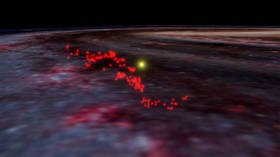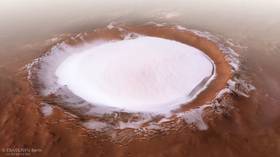Startling Milky Way mapping discovery reveals ENORMOUS gas structure in our galaxy

The Gaia mapping survey of the Milky Way has made a shocking discovery which is forcing scientists to rethink their understanding of our galaxy’s construction: a massive structure of gas that stretches 9,000 light years.
In 1879, astronomer Benjamin Gould discovered a long cloud of dust and gas, the remnants of interconnected stellar nurseries stretching 3,000 light years across, which later became known as Gould’s Belt. After recent readings were taken by the Gaia mapping survey, however, it turns out Gould’s Belt is part of an even larger structure, the largest of its kind ever discovered in our Milky Way galaxy.
Also on rt.com Journey to the ‘galactic core’: New infrared NASA images show Milky Way’s center in unprecedented detail (PHOTO)According to scientific models, the new structure is a wave of gas and dust that measures 9,000 light-years long, 400 light-years wide, and extends 500 light-years above and below the galactic plane.
It has been dubbed the Radcliffe Wave, after Harvard University’s Radcliffe Institute of Advanced Study which analyzed the data from the mapping survey.
“No astronomer expected that we live next to a giant, wave-like collection of gas, or that it forms the local arm of the Milky Way,” said astronomer Alyssa Goodman of the Smithsonian Institution.

Goodman said that both she and her team were “completely shocked when we first realised how long and straight the Radcliffe Wave is” when viewed from above.
“The Wave’s very existence is forcing us to rethink our understanding of the Milky Way’s 3D structure.”
While it is the largest gaseous structure identified in the Milky Way it is far from the largest object we have observed. Fermi gamma-ray bubbles, for example, stretch some 50,000 light-years.
Also on rt.com Astronomers detect 2nd MASSIVE neutron star collision 520 million light-years away (VIDEOS)The Gaia satellite was launched in 2013, tasked with producing the most accurate 3D map yet of our home galaxy, so if any of our endeavors into space were going to come across the Radcliffe Wave, this was it.
“The Sun lies only 500 light-years from the Wave at its closest point. It’s been right in front of our eyes all the time, but we couldn’t see it until now,” explained physicist and astronomer João Alves of the University of Vienna in Austria, who postulates that the shape may be the result of some massive object interacting with our galaxy, creating a ripple in our cosmic pond.
Like this story? Share it with a friend!














